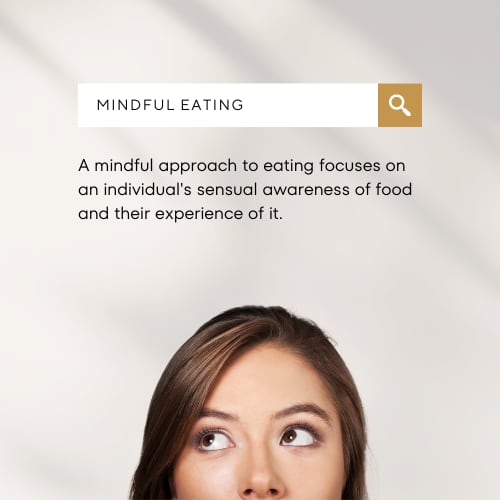 Mindful Eating: Enhancing Your Relationship with Food
Mindful Eating: Enhancing Your Relationship with Food
Mindful Eating: Enhancing Your Relationship with Food

-
Main Ideas
Learning Objective
Understand the principles of mindful eating and how it fosters a healthier relationship with food.
Behavioral Objective
Practice mindful eating techniques to slow down, savor food, and recognize hunger and fullness cues.
Key Thought
Mindful eating transforms meals into moments of awareness, promoting health and a deeper connection with your body.
-
Main Ideas
Learning Objective
Understand the principles of mindful eating and how it fosters a healthier relationship with food.
Behavioral Objective
Practice mindful eating techniques to slow down, savor food, and recognize hunger and fullness cues.
Key Thought
Mindful eating transforms meals into moments of awareness, promoting health and a deeper connection with your body.
-
Terms
- Hunger Scale
noun
A tool used to assess physical hunger and fullness before, during, and after eating, helping individuals eat more in tune with their body's needs.
- Mindful Eating
noun
The practice of being present and fully aware of the experience of eating, focusing on hunger cues, taste, texture, and feelings of fullness to foster a healthier relationship with food.
- Satiety
- noun
The feeling of fullness and satisfaction after eating, signaling the body has had enough food.
-
Terms
- Hunger Scale
noun
A tool used to assess physical hunger and fullness before, during, and after eating, helping individuals eat more in tune with their body's needs.
- Mindful Eating
noun
The practice of being present and fully aware of the experience of eating, focusing on hunger cues, taste, texture, and feelings of fullness to foster a healthier relationship with food.
- Satiety
- noun
The feeling of fullness and satisfaction after eating, signaling the body has had enough food.
Introduction
Mindful eating transforms mealtimes into moments of awareness, promoting a deeper connection with your food and body. You can foster healthier choices and improve overall well-being by slowing down, savoring each bite, and tuning into hunger and fullness cues. This topic explores how mindful eating can positively impact digestion, reduce overeating, and enhance your relationship with food.
What is Mindful Eating?
Mindful eating involves being fully present while eating, paying attention to every aspect of the food experience-from preparation to the last bite. It means acknowledging physical hunger, savoring your meal's taste, texture, and aroma, and recognizing when your body feels satisfied. This approach promotes healthier food choices, better digestion, and reduced stress.
Modern distractions like smartphones and TV often make meals rushed and thoughtless, leading to overeating and missed fullness cues. Mindful eating encourages a deliberate, reflective approach to meals, helping you reconnect with the act of nourishing your body.
How to Practice Mindful Eating
Incorporating mindful eating into your routine can start with simple, intentional actions. Follow these steps to develop your practice:
- Pause before eating: Take a few deep breaths to center yourself and reflect on why you are eating.
- Use the Hunger Scale: Assess your hunger before, during, and after the meal to eat in response to physical needs rather than emotions.
- Savor each bite: Chew thoroughly and appreciate the flavors, textures, and aromas of your food.
- Eliminate distractions: Avoid eating in front of screens or while multitasking.
- Slow your pace: Put your utensils down between bites and take your time to enjoy the meal.
- Practice gratitude: Reflect on the journey of the food and its contribution to your health.
Start small by choosing one meal or snack daily to eat mindfully. Over time, this practice can become a natural part of your routine, transforming how you approach food and nourishment.
The Hunger Scale
The Hunger Scale is a tool to help you tune into your body's hunger and fullness levels. Eating within an optimal range of 3 to 6 on the scale promotes a more balanced relationship with food:
- Beyond hungry: Depleted, dizzy, or unable to focus.
- Irritable and low on energy.
- Strong urge to eat with an empty stomach feeling.
- Thinking about food; hunger is emerging.
- Satisfied; your body has enough fuel to continue.
- Content and fully satisfied.
- Borderline too full; eating continues because the food tastes good.
- Uncomfortable and feeling heavy or bloated.
- Overfull with physical discomfort.
- Miserable and regretting overeating.
*Aim to eat at level 3 and stop when you reach level 6 for optimal balance.
Mindful Snack Practice
Objective: Develop awareness of hunger cues and improve emotional connection to food.
- Choose a snack and eat it mindfully, paying attention to the taste, texture, and how it makes you feel.
- Avoid distractions such as TV or phones.
- Reflect on whether you were truly hungry or eating out of habit or emotion.
The Hunger Journal
Objective: Track and understand personal hunger cues and eating habits.
- For a week, keep a journal of your meals, noting your hunger level before eating using the Hunger Scale.
- Record how you felt afterward and identify patterns of emotional eating or overeating.
- Use the journal to discover areas for improvement in mindful eating practices.
Gratitude at Mealtime
Objective: Incorporate gratitude into your meals to enhance mindfulness and appreciation for your food.
- Before eating, take a moment to express gratitude for the food, its source, and its nourishment.
- Write a brief reflection on how this practice influences your eating experience and overall mindset.
Mind on the Meal
Objective: Recognize how external factors and routines impact your eating experience.
- Make a list of activities or habits you typically engage in while eating, such as watching TV, reading, or checking your phone.
- Reflect on how each of these affects your eating experience (e.g., distraction, overeating, enjoyment).
- Identify which actions are part of a routine and which are driven by external factors like stress or convenience.
- Review your list and determine which distractions you'd like to reduce for a more mindful eating experience.
Empty Plate, Mind Full
Objective: Practice reducing distractions to cultivate a more mindful eating environment.
- Choose one meal a day to remove a regular distraction, such as turning off the TV or putting your phone away.
- If removing distractions feels challenging, try a simple technique: take a deep breath and place your fork down between every other bite.
- Observe how removing distractions or slowing down impacts your awareness of taste, fullness, and enjoyment.
- Gradually incorporate these techniques into other meals, noting any changes in your relationship with food.
Course Outline
![]() Session Expired from Inactivity
Session Expired from Inactivity
Do you want to?
9618 Jefferson Highway, Suite D-191
Baton Rouge LA 70809-9636
(888) 424-0032 |
support@supplementrelief.com
* Disclaimer: This page is available exclusively for SupplementRelief.com clients. None of the information on this website is intended to replace your relationship with your healthcare provider(s). Nothing should be considered medical advice. The information, knowledge, and experience shared on this website are the opinions of SupplementRelief.com. This site and its content are intended to enhance your knowledge base as YOU MAKE YOUR OWN HEALTHCARE DECISIONS in partnership with your qualified health professional.
* These statements have not been evaluated by the Food and Drug Administration. These products and services are not intended to diagnose, treat, cure, or prevent disease.
* There is NO GUARANTEE OF SPECIFIC RESULTS for the products or services offered, and the RESULTS CAN VARY for each individual. Any results claimed by our customers are based on individual experiences that are unique and cannot be guaranteed.
FirstFitness Nutrition and NuMedica may be promoted and sold on the internet ONLY by Authorized Resellers who have been approved by and have registered their website domain with these companies. They strictly prohibit, and actively monitor, the UNAUTHORIZED SALE or RESALE of their products in ALL online public shopping portals including Amazon, eBay, and others and into other countries. All products purchased in SupplementRelief.com are for PERSONAL USE ONLY and CANNOT BE RESOLD to others. Please report violations of Reseller Policy directly to FirstFitness Nutrition at 800.621.4348 and to NuMedica at 800.869.8100.
The content and photographs on this website are copyrighted or Licensed Material and may not be downloaded for other than personal use. Republication, retransmission, reproduction, or any other use of the content or photographs is prohibited. ©2010-2024 SupplementRelief.com.
Are you sure you want to remove this item?


